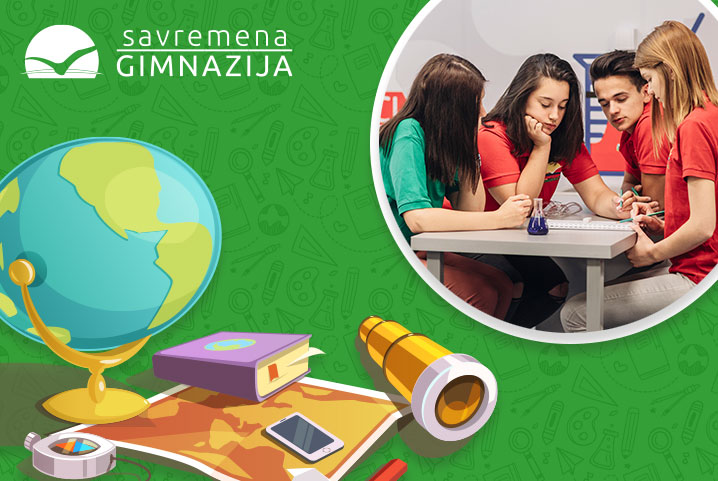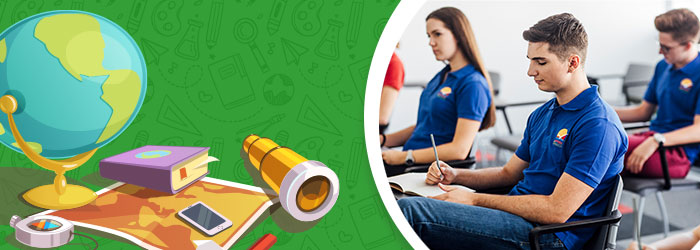
Year 3 students visited Sirmium (Sremska Mitrovica) where, as a part of their outdoor education, divided in groups they solved tasks prepared by their teachers.
After a short trip, the students reached the defined destination and familiarised themselves with tasks from different subjects.
Philosophy
A philosophical overview started with reading Hannah Arendt’s text Race-thinking before racism (from the book The Origins of Totalitarianism) and visiting the exhibition in the Museum of Srem devoted to war crimes in World War II. Later, through an essay, the students dealt with the following question:
Did racism exist in the regions of the Kingdom of Yugoslavia, that is in the Independent State of Croatia?
Two best works were the works of:
- Janko Kusturica, Nikola Ćorović, Stefan Stojanović and Stefan Savić
- Uroš Tirnanić, Marko Vlahović, Relja Jovanović and Tao Filip Guan
Geography
The landscape of Vojvodina predominantly is a plain, with the altitude not exceeding 100 m. Several morphological features can be identified there. Firstly, two Pannonian island mountains – Fruška gora in Srem and Vršac Hill in Banat. Geography teacher prepared outline map for the students who, while using ThingLink or Canva tools, had to insert the following:
- the names of mountains in Vojvodina;
- the names of rivers, canals and lakes in Vojvodina;
- the names of inland dunes and loess plateaus in Vojvodina;
- the names of three regions in Vojvodina;
- the names of cities in Vojvodina.
The exceptional works belong to:
The Serbian language and literature
The subject Serbian language and literature presented a special challenge. Observing a model, the students were supposed to create travelogues describing what they had seen or learnt. They had to take photos of all the destinations they described as well as to create videos of the same places.
The best travelogues:
- III-1 (ST DEMETRIUS CHURCH)
Authors: Mihailo Marjanović, Andrej Elez, Nikola Krstajić, Balša Drobnjak - III-4 (ST IRINEJ BRIDGE)
Authors: Uroš Tirnanić, Marko Vlahović, Relja Jovanović, Filip Guan Tao
Videos:
- III-1 (ST DEMETRIUS CHURCH)
Authors: Mihailo Marjanović, Andrej Elez, Nikola Krstajić, Balša Drobnjak - III-4 (ST IRINEJ BRIDGE)
Authors: Uroš Tirnanić, Marko Vlahović, Relja Jovanović, Filip Guan Ta
- III-5 (ST DEMETRIUS CHURCH)
Authors: Danilo Jestrović Kosta Arsenović, Andrej Perezić, MIhailo Vidaković
Besides travelogues, the students made short films (up to 5 minutes) in which they presented history and fun facts of sites allocated to them:
- Janko, Ćorović, Savić i Stefan Stojanović
- Anđela Velimirović
- Uroš Tirnanić
- Aleksandra Mosurović
History and Introduction to geopolitics
Teachers of History and Introduction to geopolitics prepared a set of questions, including the following:
- What was the consequence of Serbian participation in the Wars of the Holy League?
- What Military Frontier regiment did Mitrovica belong to?
- What was the name used for the Serbian volunteers participating in the last Austrian-Turkish war, and who was their commander?
- Submit the picture of the battle model that took place near Sremska Mitrovica and briefly describe the course and the outcomes of the battle etc.
To complete the task successfully, it was necessary to listen attentively to the curator at the Museum of Srem, as well as to the teacher’s lecture at the Memorial Cemetery in Sremska Mitrovica, where they learnt what each tomb represents, what used to be there in the place of today’s Memorial Cemetery and what it is important, what famous Serbian painter was killed at the place of today’s Memorial Cemetery and who are the four national heroes originating from Srem, buried there etc.
Religion and civilisation
The objective of this subject, introduced into the Secondary school curriculum, is to focus on topics related to similarities and differences between the Orthodox and Catholic churches. In the form of essay, the students presented their responses comprised in the research on the following elements:
- presenting differences between Catholicism and Orthodoxy;
- presenting similarities between Catholicism and Orthodoxy;
- presenting the research results carried out by students in the form of a poll, with minimum 10 interviewees. The research was based on the questions with reference to public opinion and their awareness of similarities and differences between these two religious teachings;
- presenting conclusions supported by arguments regarding the topic on the significance of these differences; do they connect people or set them apart.
ICT, Arts and Design
Using the app ThingLink with regard to ITC and Arts and Design subjects, the students presented some of the sites (the church, museum or park) in the form of an interactive 360° video, in which explanations and photos showing the historical background of Sirmium were inserted. All the materials the students used had to refer to sites they had visited.
The best works were made by:
- Aleksandra Mosurović III-1;
- Uroš Tirnanić III-4;
- Vuk Ikodinović III-4
Using the app Mosaically the students turned the photos taken in Sremska Mitrovica into mosaics.
The special task was to use the app Canva, selecting the option Calendar and incorporate high-resolution photos, depicting beautiful places of Sremska Mitrovica, into the next-year’s calendar.
The best works:
Outdoor education as the rich resources of general culture
A variety of tasks enabled students to learn more about this place that has so much to offer. Among other places, in Sremska Mitrovica, they had the opportunity to visit Greek Catholic church, a Catholic church and an Orthodox church, and to broaden their knowledge of history and general culture, as something so special about Grammar school students.
We say goodbye till the next occasion for the outdoor education experience. We hope you have enjoyed the contributions and works of our Savremena students.


















